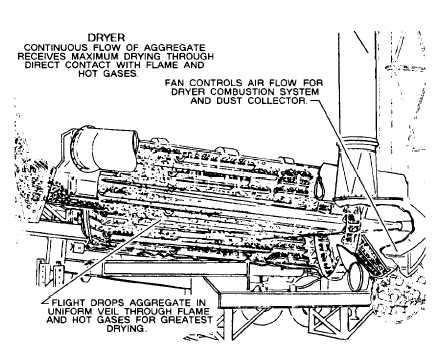Figure 8-7.-Dryer.
when calibrating gates through which fine aggregates
are flowing.
For uniform flow, gates that feed coarse aggregate
should not be set at a height less than 2 1/2 to 3 times
the largest aggregate size; for example, if a gate is
feeding aggregate that has a maximum size of 1 inch,
the gate should not be set at less than 2 1/2 or 3 inches.
Sometimes it may be necessary to restrict the opening
width to provide the necessary opening height.
Before you set the cold-feed gates, the production
volume of the plant in normal operation must be
determined. this can be estimated from the plant size
(dryer, screening, and mixing capacities) and mixing
cycle time. Then, using the gate calibration charts, each
gate is set to deliver its share of the desired volume of
aggregate.
Grading of the individual cold aggregate is
determined by sieve analysis. The percentage of each
size of aggregate to be used is calculated by trial and
error.
The proportions required on the basis of these
percentages will determine the gate settings. These
settings should be checked by the same method used in
calibrating the gate originally.
The setting should be considered tentative because
the cold aggregate may vary in grading and moisture
with the weather and other conditions that will affect its
bulking and flow.
The hot bins should be watched carefully and the
cold aggregate feeders regulated to see that they do not
run out of material or overflow.
Dryer
From the aggregate cold-feed system, aggregates
are delivered to the dryer. The dryer (fig. 8-7) is a
revolving cylinder in which the aggregate is dried and
heated by an oil or gas burner. The cylinders used range
from 3 to 10 feet in diameter and from 15 to 40 feet in
length. A cylinder is usually equipped with longitudinal
cups or channels (called lifting flights) that lift the
aggregate and drop it in veils through the burner flame
and hot gases. The slope of the cylinder, its speed,
diameter, length, and the arrangement and number of
flights control the length of time required for the
aggregate to pass through the dryer.
The dryer performs two functions: (1) it removes
moisture from the aggregate and (2) it heats the
aggregate to mixing temperature.
The dryer includes an oil or gas burner with a blower
fan to provide the primary air for combustion of the fuel
and an exhaust fan to create a draft through the dryer.
For efficient dryer operation, the air that is combined
with the fuel for combustion must be in balance with the
8-5


